Detailed Audit and Ethical Analysis of Orora Limited's Financials
VerifiedAdded on 2023/06/12
|16
|2907
|298
Report
AI Summary
This report provides a comprehensive analysis of Orora Limited's financial statements, focusing on auditing and ethical considerations. It examines the nature of materiality, the company's financial performance through key ratios such as financial leverage, return on equity, net profit margin, and current and quick ratios, and the associated audit procedures. The report also reviews the statement of cash flows, evaluates going concern risks related to foreign exchange, interest rates, and liquidity, and discusses the audit assertions and their application in testing internal controls and financial reporting procedures. Key risk areas, such as low quick ratio and high financial leverage, are addressed within the audit plan, emphasizing the importance of liquidity risk management and understanding foreign exchange and credit risks. The analysis includes recommendations for mitigating these risks through measures like verifying foreign exchange contracts, assessing risk management arrangements, and evaluating counterparty approval systems.
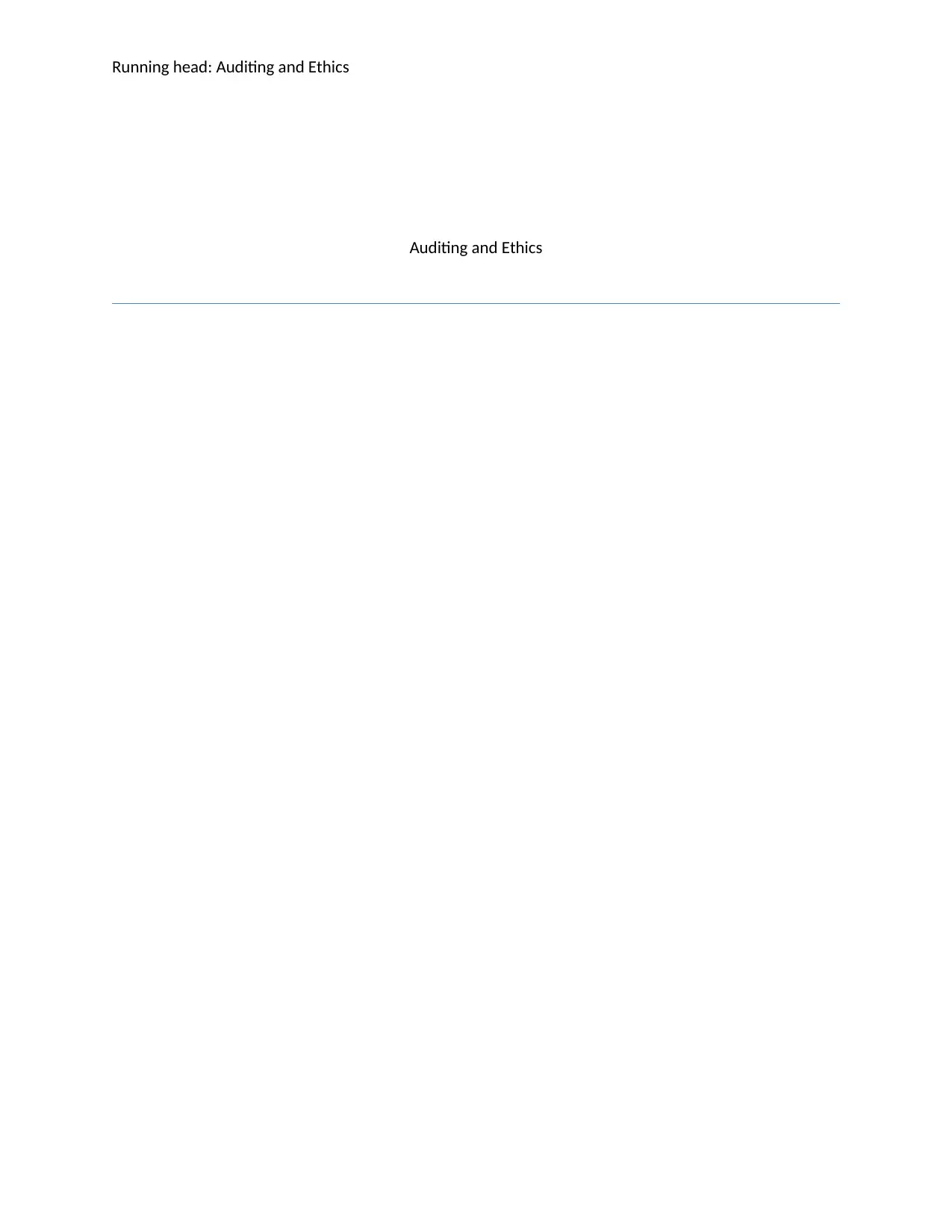
Running head: Auditing and Ethics
Auditing and Ethics
Auditing and Ethics
Paraphrase This Document
Need a fresh take? Get an instant paraphrase of this document with our AI Paraphraser

Auditing and Ethics 1
Contents
Introduction.................................................................................................................................................2
Section 1......................................................................................................................................................3
Analysis of the nature of materiality and considerations employed in arriving at materiality..................3
Section 2......................................................................................................................................................5
Review of the performance of the company and its business and the assertions and procedures of audit 5
Section 3....................................................................................................................................................11
Reviewing the statement of cash flows and evaluation of the going concern risk of the company........11
Conclusion.................................................................................................................................................13
References.................................................................................................................................................14
Contents
Introduction.................................................................................................................................................2
Section 1......................................................................................................................................................3
Analysis of the nature of materiality and considerations employed in arriving at materiality..................3
Section 2......................................................................................................................................................5
Review of the performance of the company and its business and the assertions and procedures of audit 5
Section 3....................................................................................................................................................11
Reviewing the statement of cash flows and evaluation of the going concern risk of the company........11
Conclusion.................................................................................................................................................13
References.................................................................................................................................................14
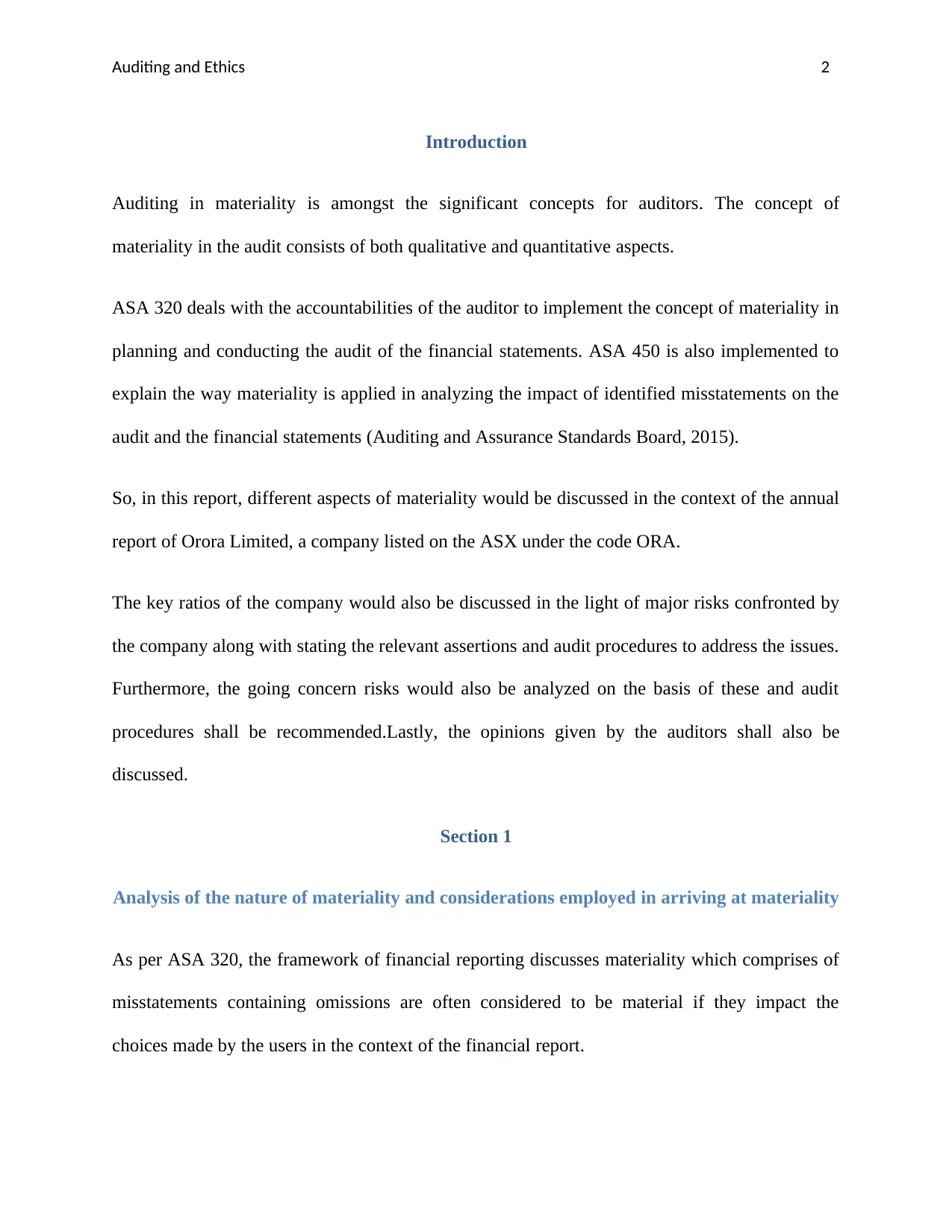
Auditing and Ethics 2
Introduction
Auditing in materiality is amongst the significant concepts for auditors. The concept of
materiality in the audit consists of both qualitative and quantitative aspects.
ASA 320 deals with the accountabilities of the auditor to implement the concept of materiality in
planning and conducting the audit of the financial statements. ASA 450 is also implemented to
explain the way materiality is applied in analyzing the impact of identified misstatements on the
audit and the financial statements (Auditing and Assurance Standards Board, 2015).
So, in this report, different aspects of materiality would be discussed in the context of the annual
report of Orora Limited, a company listed on the ASX under the code ORA.
The key ratios of the company would also be discussed in the light of major risks confronted by
the company along with stating the relevant assertions and audit procedures to address the issues.
Furthermore, the going concern risks would also be analyzed on the basis of these and audit
procedures shall be recommended.Lastly, the opinions given by the auditors shall also be
discussed.
Section 1
Analysis of the nature of materiality and considerations employed in arriving at materiality
As per ASA 320, the framework of financial reporting discusses materiality which comprises of
misstatements containing omissions are often considered to be material if they impact the
choices made by the users in the context of the financial report.
Introduction
Auditing in materiality is amongst the significant concepts for auditors. The concept of
materiality in the audit consists of both qualitative and quantitative aspects.
ASA 320 deals with the accountabilities of the auditor to implement the concept of materiality in
planning and conducting the audit of the financial statements. ASA 450 is also implemented to
explain the way materiality is applied in analyzing the impact of identified misstatements on the
audit and the financial statements (Auditing and Assurance Standards Board, 2015).
So, in this report, different aspects of materiality would be discussed in the context of the annual
report of Orora Limited, a company listed on the ASX under the code ORA.
The key ratios of the company would also be discussed in the light of major risks confronted by
the company along with stating the relevant assertions and audit procedures to address the issues.
Furthermore, the going concern risks would also be analyzed on the basis of these and audit
procedures shall be recommended.Lastly, the opinions given by the auditors shall also be
discussed.
Section 1
Analysis of the nature of materiality and considerations employed in arriving at materiality
As per ASA 320, the framework of financial reporting discusses materiality which comprises of
misstatements containing omissions are often considered to be material if they impact the
choices made by the users in the context of the financial report.
⊘ This is a preview!⊘
Do you want full access?
Subscribe today to unlock all pages.

Trusted by 1+ million students worldwide
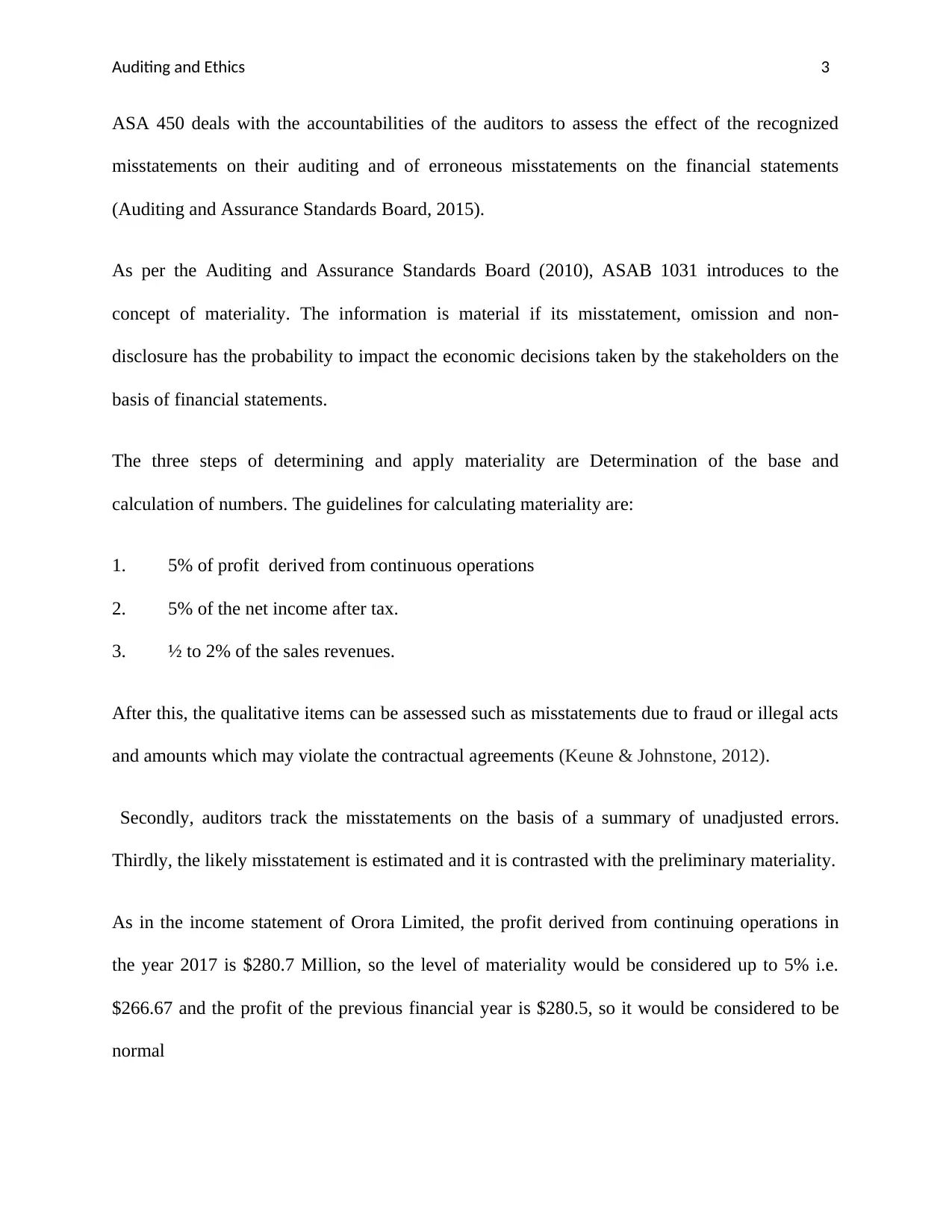
Auditing and Ethics 3
ASA 450 deals with the accountabilities of the auditors to assess the effect of the recognized
misstatements on their auditing and of erroneous misstatements on the financial statements
(Auditing and Assurance Standards Board, 2015).
As per the Auditing and Assurance Standards Board (2010), ASAB 1031 introduces to the
concept of materiality. The information is material if its misstatement, omission and non-
disclosure has the probability to impact the economic decisions taken by the stakeholders on the
basis of financial statements.
The three steps of determining and apply materiality are Determination of the base and
calculation of numbers. The guidelines for calculating materiality are:
1. 5% of profit derived from continuous operations
2. 5% of the net income after tax.
3. ½ to 2% of the sales revenues.
After this, the qualitative items can be assessed such as misstatements due to fraud or illegal acts
and amounts which may violate the contractual agreements (Keune & Johnstone, 2012).
Secondly, auditors track the misstatements on the basis of a summary of unadjusted errors.
Thirdly, the likely misstatement is estimated and it is contrasted with the preliminary materiality.
As in the income statement of Orora Limited, the profit derived from continuing operations in
the year 2017 is $280.7 Million, so the level of materiality would be considered up to 5% i.e.
$266.67 and the profit of the previous financial year is $280.5, so it would be considered to be
normal
ASA 450 deals with the accountabilities of the auditors to assess the effect of the recognized
misstatements on their auditing and of erroneous misstatements on the financial statements
(Auditing and Assurance Standards Board, 2015).
As per the Auditing and Assurance Standards Board (2010), ASAB 1031 introduces to the
concept of materiality. The information is material if its misstatement, omission and non-
disclosure has the probability to impact the economic decisions taken by the stakeholders on the
basis of financial statements.
The three steps of determining and apply materiality are Determination of the base and
calculation of numbers. The guidelines for calculating materiality are:
1. 5% of profit derived from continuous operations
2. 5% of the net income after tax.
3. ½ to 2% of the sales revenues.
After this, the qualitative items can be assessed such as misstatements due to fraud or illegal acts
and amounts which may violate the contractual agreements (Keune & Johnstone, 2012).
Secondly, auditors track the misstatements on the basis of a summary of unadjusted errors.
Thirdly, the likely misstatement is estimated and it is contrasted with the preliminary materiality.
As in the income statement of Orora Limited, the profit derived from continuing operations in
the year 2017 is $280.7 Million, so the level of materiality would be considered up to 5% i.e.
$266.67 and the profit of the previous financial year is $280.5, so it would be considered to be
normal
Paraphrase This Document
Need a fresh take? Get an instant paraphrase of this document with our AI Paraphraser
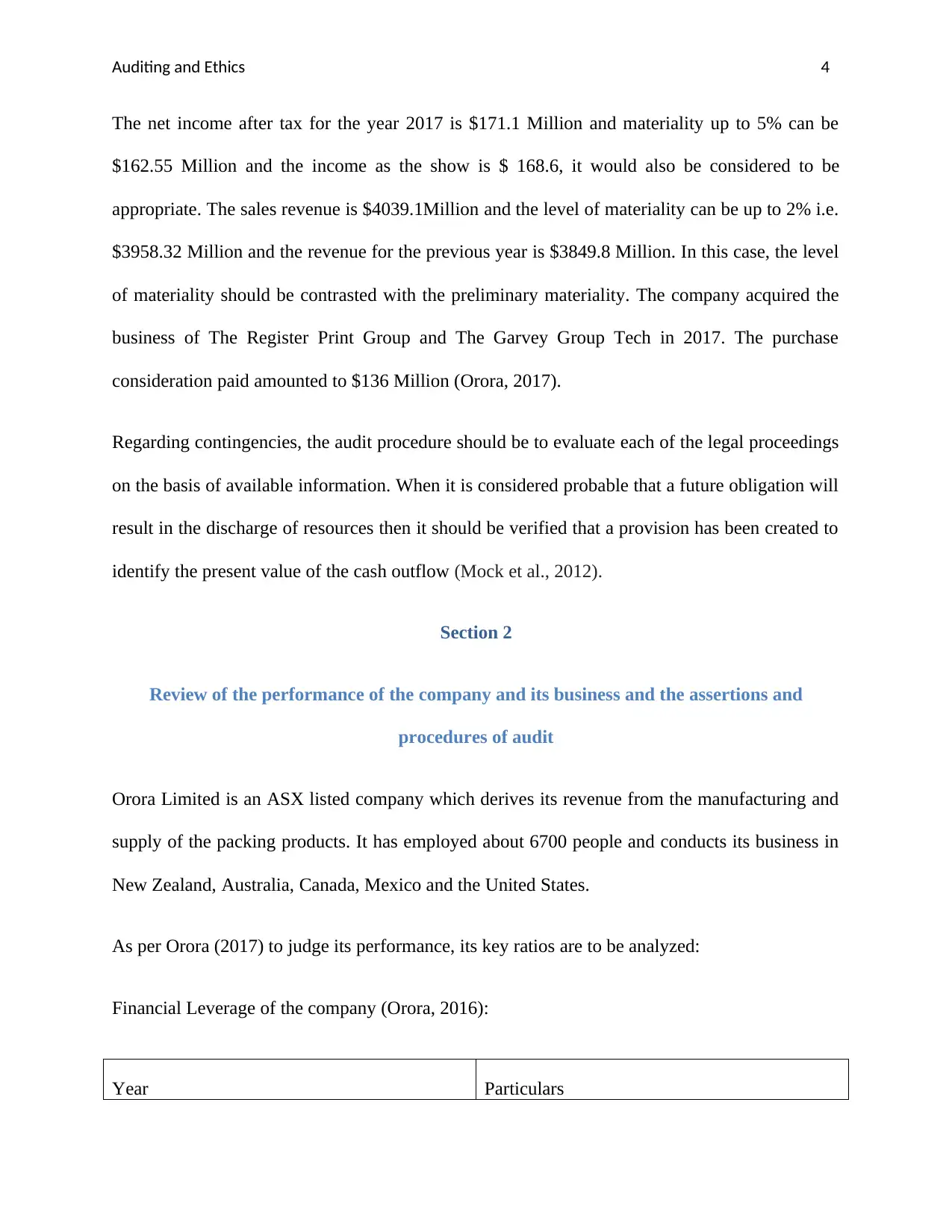
Auditing and Ethics 4
The net income after tax for the year 2017 is $171.1 Million and materiality up to 5% can be
$162.55 Million and the income as the show is $ 168.6, it would also be considered to be
appropriate. The sales revenue is $4039.1Million and the level of materiality can be up to 2% i.e.
$3958.32 Million and the revenue for the previous year is $3849.8 Million. In this case, the level
of materiality should be contrasted with the preliminary materiality. The company acquired the
business of The Register Print Group and The Garvey Group Tech in 2017. The purchase
consideration paid amounted to $136 Million (Orora, 2017).
Regarding contingencies, the audit procedure should be to evaluate each of the legal proceedings
on the basis of available information. When it is considered probable that a future obligation will
result in the discharge of resources then it should be verified that a provision has been created to
identify the present value of the cash outflow (Mock et al., 2012).
Section 2
Review of the performance of the company and its business and the assertions and
procedures of audit
Orora Limited is an ASX listed company which derives its revenue from the manufacturing and
supply of the packing products. It has employed about 6700 people and conducts its business in
New Zealand, Australia, Canada, Mexico and the United States.
As per Orora (2017) to judge its performance, its key ratios are to be analyzed:
Financial Leverage of the company (Orora, 2016):
Year Particulars
The net income after tax for the year 2017 is $171.1 Million and materiality up to 5% can be
$162.55 Million and the income as the show is $ 168.6, it would also be considered to be
appropriate. The sales revenue is $4039.1Million and the level of materiality can be up to 2% i.e.
$3958.32 Million and the revenue for the previous year is $3849.8 Million. In this case, the level
of materiality should be contrasted with the preliminary materiality. The company acquired the
business of The Register Print Group and The Garvey Group Tech in 2017. The purchase
consideration paid amounted to $136 Million (Orora, 2017).
Regarding contingencies, the audit procedure should be to evaluate each of the legal proceedings
on the basis of available information. When it is considered probable that a future obligation will
result in the discharge of resources then it should be verified that a provision has been created to
identify the present value of the cash outflow (Mock et al., 2012).
Section 2
Review of the performance of the company and its business and the assertions and
procedures of audit
Orora Limited is an ASX listed company which derives its revenue from the manufacturing and
supply of the packing products. It has employed about 6700 people and conducts its business in
New Zealand, Australia, Canada, Mexico and the United States.
As per Orora (2017) to judge its performance, its key ratios are to be analyzed:
Financial Leverage of the company (Orora, 2016):
Year Particulars
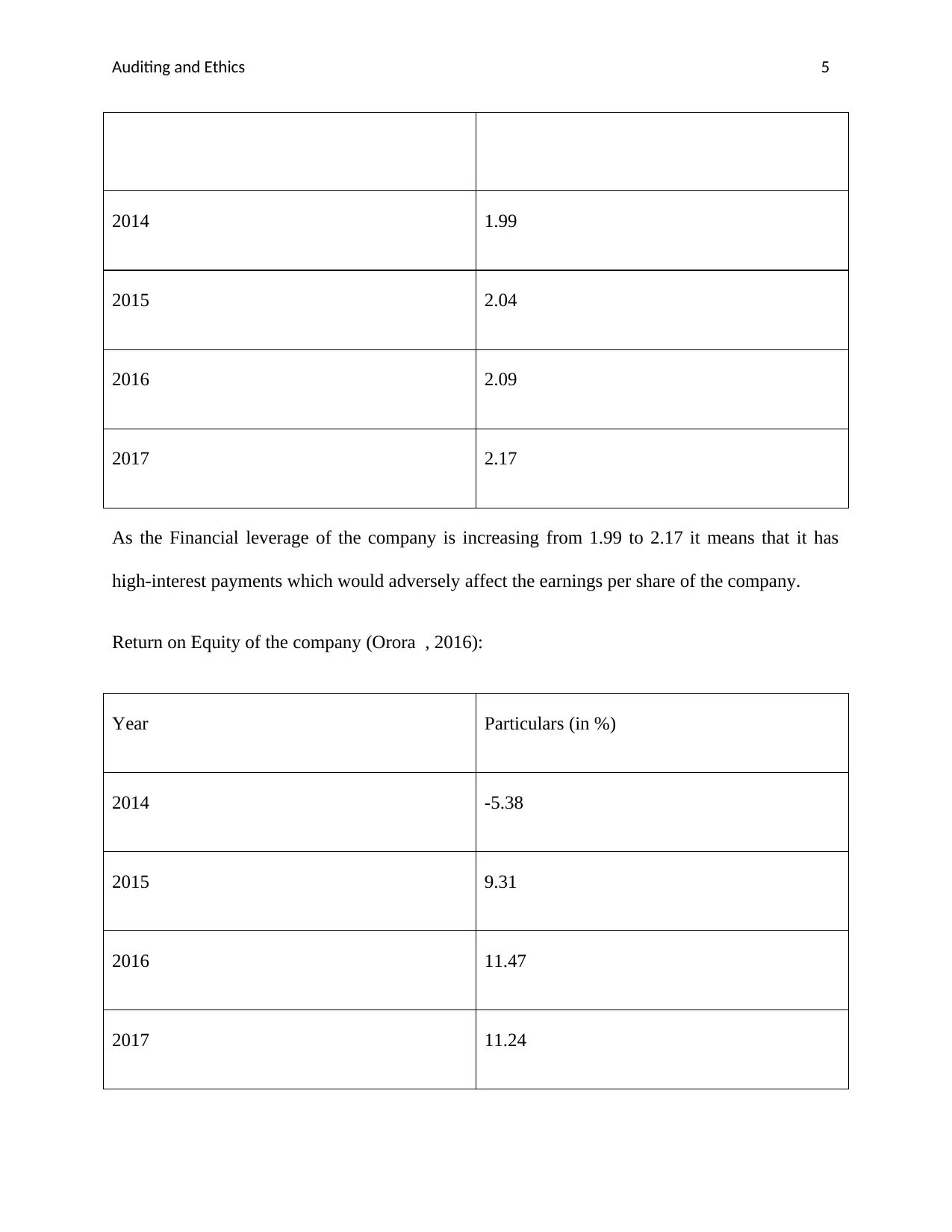
Auditing and Ethics 5
2014 1.99
2015 2.04
2016 2.09
2017 2.17
As the Financial leverage of the company is increasing from 1.99 to 2.17 it means that it has
high-interest payments which would adversely affect the earnings per share of the company.
Return on Equity of the company (Orora , 2016):
Year Particulars (in %)
2014 -5.38
2015 9.31
2016 11.47
2017 11.24
2014 1.99
2015 2.04
2016 2.09
2017 2.17
As the Financial leverage of the company is increasing from 1.99 to 2.17 it means that it has
high-interest payments which would adversely affect the earnings per share of the company.
Return on Equity of the company (Orora , 2016):
Year Particulars (in %)
2014 -5.38
2015 9.31
2016 11.47
2017 11.24
⊘ This is a preview!⊘
Do you want full access?
Subscribe today to unlock all pages.

Trusted by 1+ million students worldwide
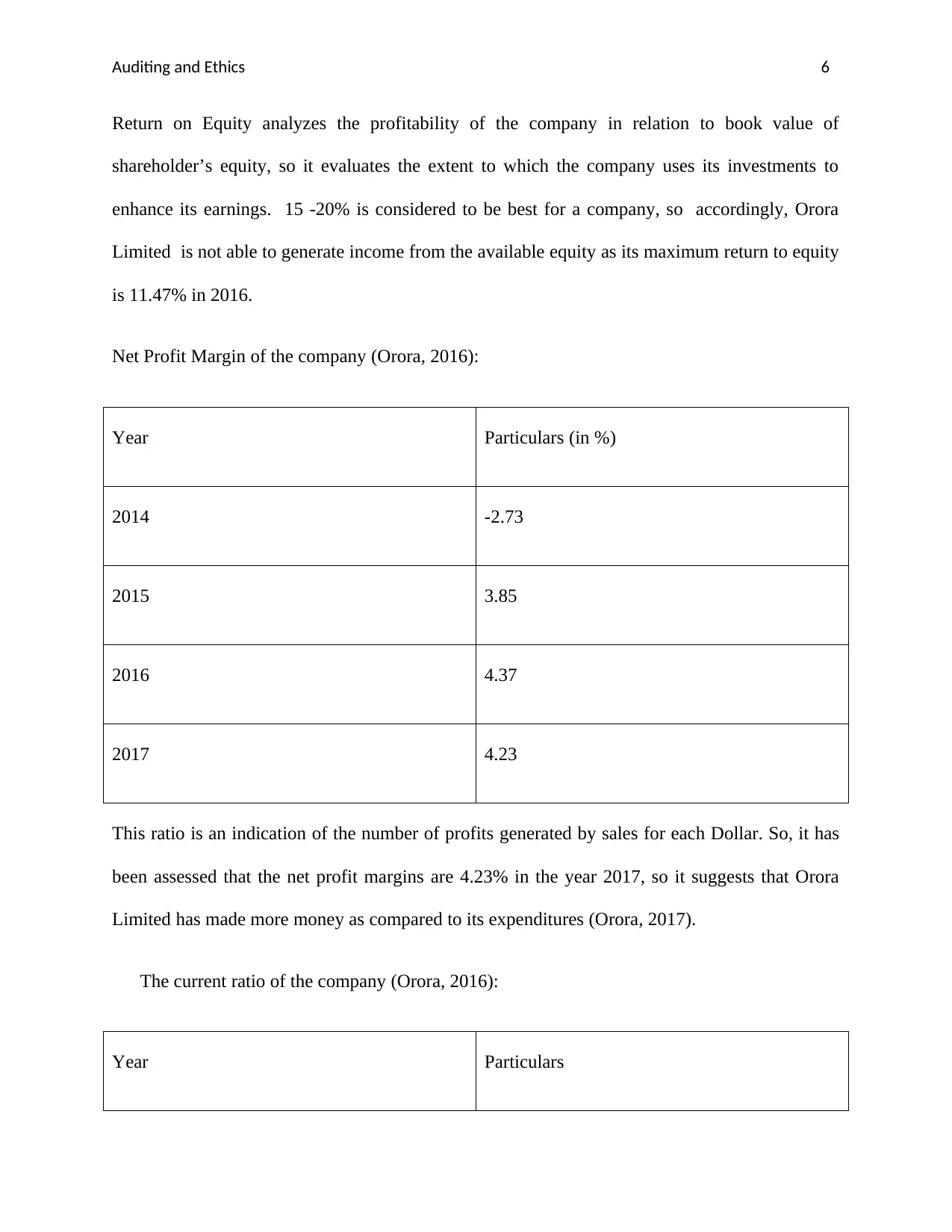
Auditing and Ethics 6
Return on Equity analyzes the profitability of the company in relation to book value of
shareholder’s equity, so it evaluates the extent to which the company uses its investments to
enhance its earnings. 15 -20% is considered to be best for a company, so accordingly, Orora
Limited is not able to generate income from the available equity as its maximum return to equity
is 11.47% in 2016.
Net Profit Margin of the company (Orora, 2016):
Year Particulars (in %)
2014 -2.73
2015 3.85
2016 4.37
2017 4.23
This ratio is an indication of the number of profits generated by sales for each Dollar. So, it has
been assessed that the net profit margins are 4.23% in the year 2017, so it suggests that Orora
Limited has made more money as compared to its expenditures (Orora, 2017).
The current ratio of the company (Orora, 2016):
Year Particulars
Return on Equity analyzes the profitability of the company in relation to book value of
shareholder’s equity, so it evaluates the extent to which the company uses its investments to
enhance its earnings. 15 -20% is considered to be best for a company, so accordingly, Orora
Limited is not able to generate income from the available equity as its maximum return to equity
is 11.47% in 2016.
Net Profit Margin of the company (Orora, 2016):
Year Particulars (in %)
2014 -2.73
2015 3.85
2016 4.37
2017 4.23
This ratio is an indication of the number of profits generated by sales for each Dollar. So, it has
been assessed that the net profit margins are 4.23% in the year 2017, so it suggests that Orora
Limited has made more money as compared to its expenditures (Orora, 2017).
The current ratio of the company (Orora, 2016):
Year Particulars
Paraphrase This Document
Need a fresh take? Get an instant paraphrase of this document with our AI Paraphraser
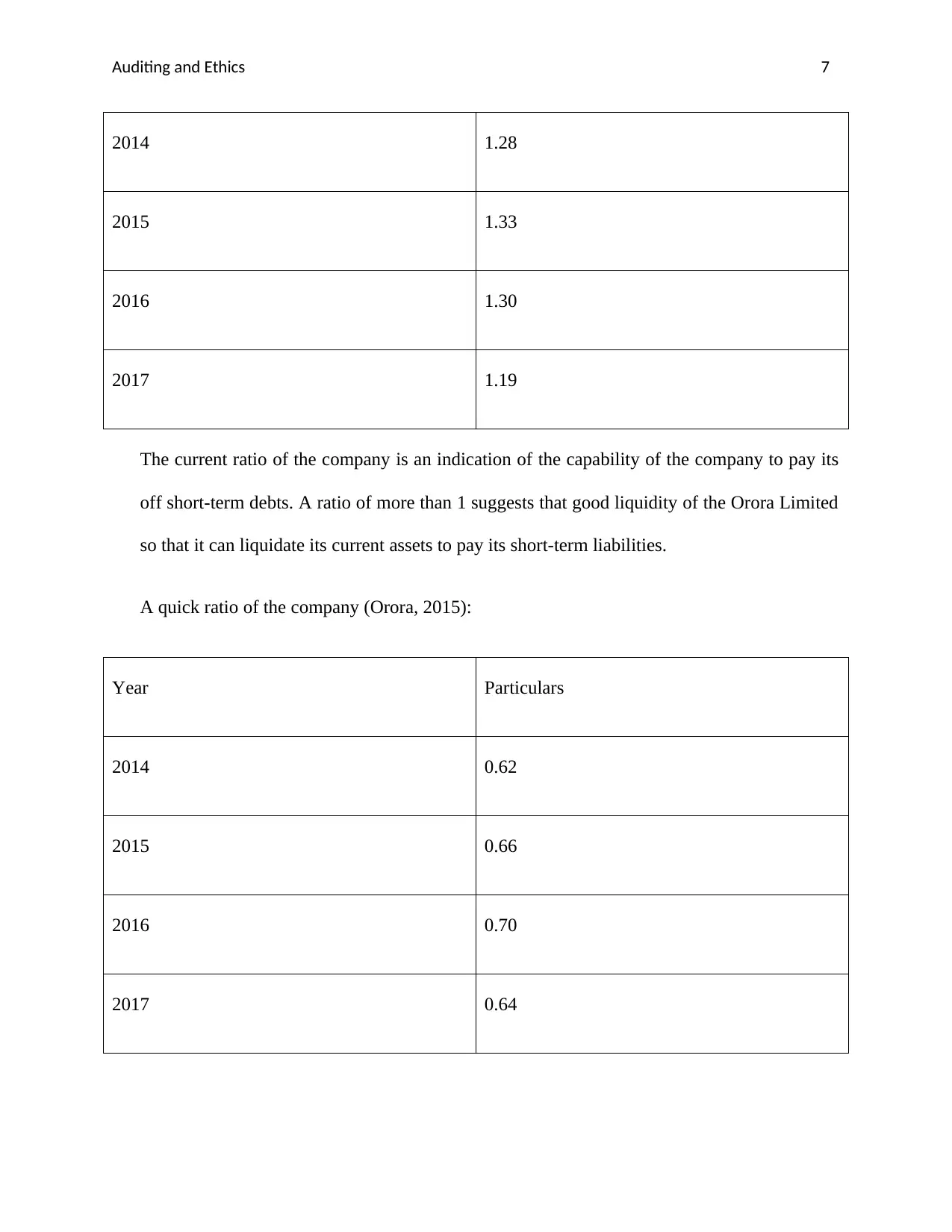
Auditing and Ethics 7
2014 1.28
2015 1.33
2016 1.30
2017 1.19
The current ratio of the company is an indication of the capability of the company to pay its
off short-term debts. A ratio of more than 1 suggests that good liquidity of the Orora Limited
so that it can liquidate its current assets to pay its short-term liabilities.
A quick ratio of the company (Orora, 2015):
Year Particulars
2014 0.62
2015 0.66
2016 0.70
2017 0.64
2014 1.28
2015 1.33
2016 1.30
2017 1.19
The current ratio of the company is an indication of the capability of the company to pay its
off short-term debts. A ratio of more than 1 suggests that good liquidity of the Orora Limited
so that it can liquidate its current assets to pay its short-term liabilities.
A quick ratio of the company (Orora, 2015):
Year Particulars
2014 0.62
2015 0.66
2016 0.70
2017 0.64
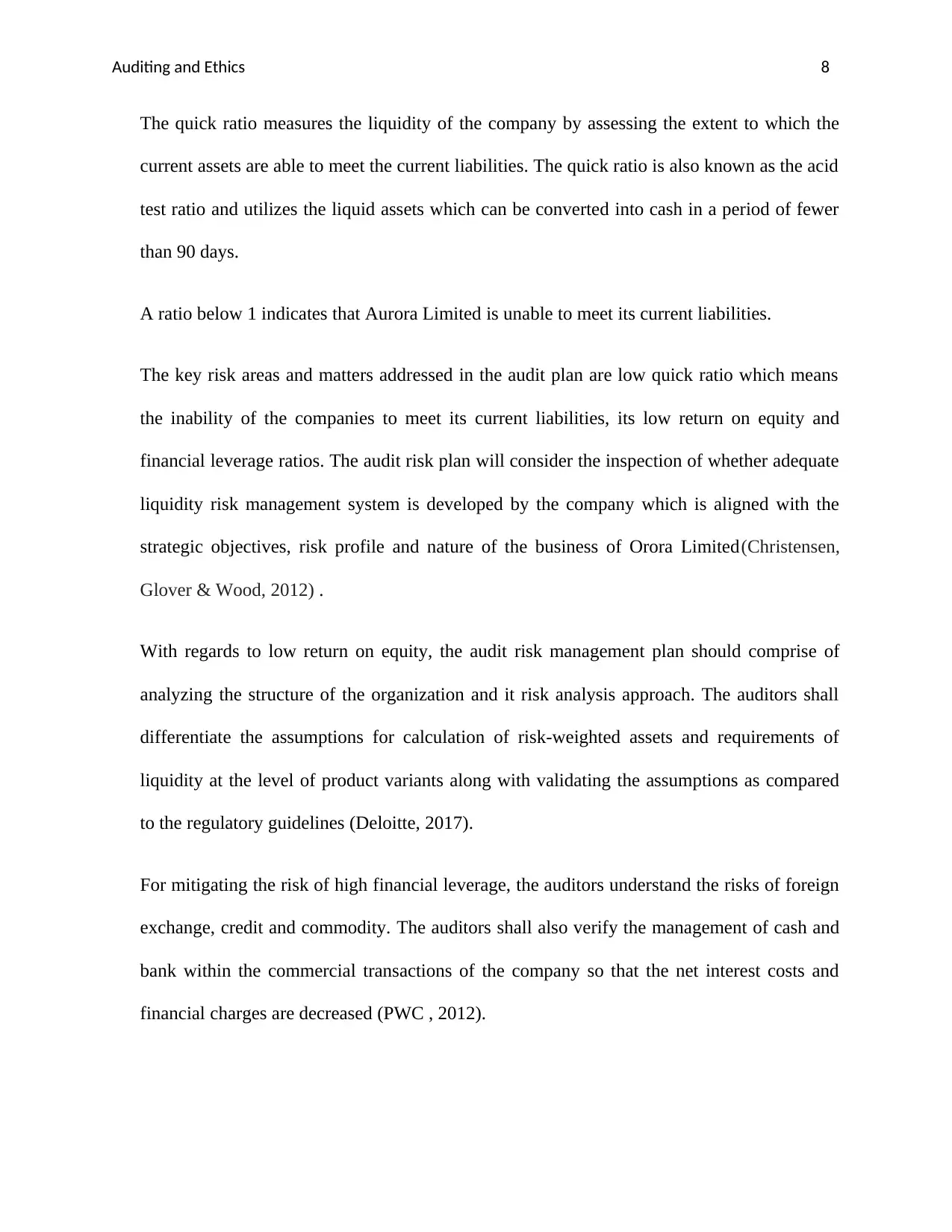
Auditing and Ethics 8
The quick ratio measures the liquidity of the company by assessing the extent to which the
current assets are able to meet the current liabilities. The quick ratio is also known as the acid
test ratio and utilizes the liquid assets which can be converted into cash in a period of fewer
than 90 days.
A ratio below 1 indicates that Aurora Limited is unable to meet its current liabilities.
The key risk areas and matters addressed in the audit plan are low quick ratio which means
the inability of the companies to meet its current liabilities, its low return on equity and
financial leverage ratios. The audit risk plan will consider the inspection of whether adequate
liquidity risk management system is developed by the company which is aligned with the
strategic objectives, risk profile and nature of the business of Orora Limited(Christensen,
Glover & Wood, 2012) .
With regards to low return on equity, the audit risk management plan should comprise of
analyzing the structure of the organization and it risk analysis approach. The auditors shall
differentiate the assumptions for calculation of risk-weighted assets and requirements of
liquidity at the level of product variants along with validating the assumptions as compared
to the regulatory guidelines (Deloitte, 2017).
For mitigating the risk of high financial leverage, the auditors understand the risks of foreign
exchange, credit and commodity. The auditors shall also verify the management of cash and
bank within the commercial transactions of the company so that the net interest costs and
financial charges are decreased (PWC , 2012).
The quick ratio measures the liquidity of the company by assessing the extent to which the
current assets are able to meet the current liabilities. The quick ratio is also known as the acid
test ratio and utilizes the liquid assets which can be converted into cash in a period of fewer
than 90 days.
A ratio below 1 indicates that Aurora Limited is unable to meet its current liabilities.
The key risk areas and matters addressed in the audit plan are low quick ratio which means
the inability of the companies to meet its current liabilities, its low return on equity and
financial leverage ratios. The audit risk plan will consider the inspection of whether adequate
liquidity risk management system is developed by the company which is aligned with the
strategic objectives, risk profile and nature of the business of Orora Limited(Christensen,
Glover & Wood, 2012) .
With regards to low return on equity, the audit risk management plan should comprise of
analyzing the structure of the organization and it risk analysis approach. The auditors shall
differentiate the assumptions for calculation of risk-weighted assets and requirements of
liquidity at the level of product variants along with validating the assumptions as compared
to the regulatory guidelines (Deloitte, 2017).
For mitigating the risk of high financial leverage, the auditors understand the risks of foreign
exchange, credit and commodity. The auditors shall also verify the management of cash and
bank within the commercial transactions of the company so that the net interest costs and
financial charges are decreased (PWC , 2012).
⊘ This is a preview!⊘
Do you want full access?
Subscribe today to unlock all pages.

Trusted by 1+ million students worldwide
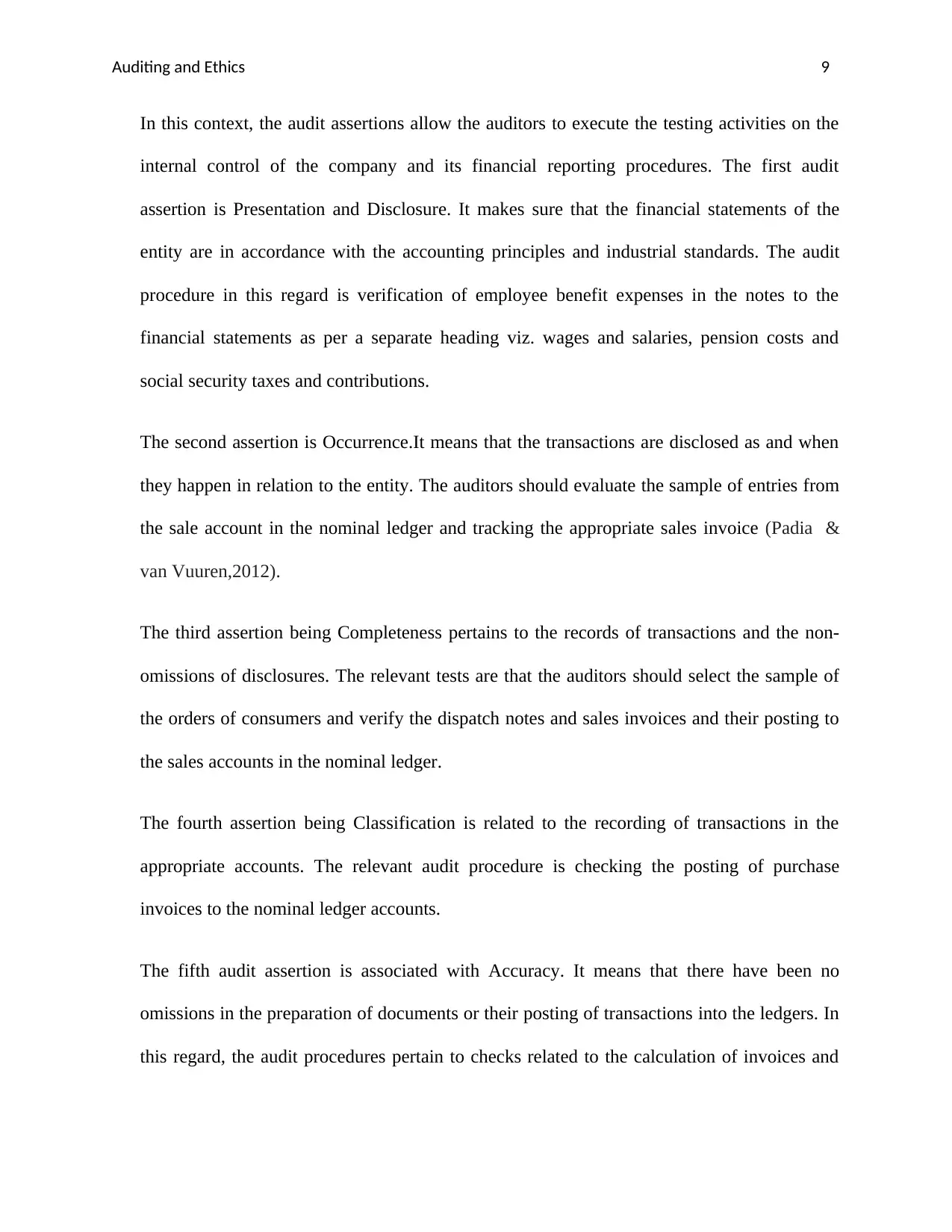
Auditing and Ethics 9
In this context, the audit assertions allow the auditors to execute the testing activities on the
internal control of the company and its financial reporting procedures. The first audit
assertion is Presentation and Disclosure. It makes sure that the financial statements of the
entity are in accordance with the accounting principles and industrial standards. The audit
procedure in this regard is verification of employee benefit expenses in the notes to the
financial statements as per a separate heading viz. wages and salaries, pension costs and
social security taxes and contributions.
The second assertion is Occurrence.It means that the transactions are disclosed as and when
they happen in relation to the entity. The auditors should evaluate the sample of entries from
the sale account in the nominal ledger and tracking the appropriate sales invoice (Padia &
van Vuuren,2012).
The third assertion being Completeness pertains to the records of transactions and the non-
omissions of disclosures. The relevant tests are that the auditors should select the sample of
the orders of consumers and verify the dispatch notes and sales invoices and their posting to
the sales accounts in the nominal ledger.
The fourth assertion being Classification is related to the recording of transactions in the
appropriate accounts. The relevant audit procedure is checking the posting of purchase
invoices to the nominal ledger accounts.
The fifth audit assertion is associated with Accuracy. It means that there have been no
omissions in the preparation of documents or their posting of transactions into the ledgers. In
this regard, the audit procedures pertain to checks related to the calculation of invoices and
In this context, the audit assertions allow the auditors to execute the testing activities on the
internal control of the company and its financial reporting procedures. The first audit
assertion is Presentation and Disclosure. It makes sure that the financial statements of the
entity are in accordance with the accounting principles and industrial standards. The audit
procedure in this regard is verification of employee benefit expenses in the notes to the
financial statements as per a separate heading viz. wages and salaries, pension costs and
social security taxes and contributions.
The second assertion is Occurrence.It means that the transactions are disclosed as and when
they happen in relation to the entity. The auditors should evaluate the sample of entries from
the sale account in the nominal ledger and tracking the appropriate sales invoice (Padia &
van Vuuren,2012).
The third assertion being Completeness pertains to the records of transactions and the non-
omissions of disclosures. The relevant tests are that the auditors should select the sample of
the orders of consumers and verify the dispatch notes and sales invoices and their posting to
the sales accounts in the nominal ledger.
The fourth assertion being Classification is related to the recording of transactions in the
appropriate accounts. The relevant audit procedure is checking the posting of purchase
invoices to the nominal ledger accounts.
The fifth audit assertion is associated with Accuracy. It means that there have been no
omissions in the preparation of documents or their posting of transactions into the ledgers. In
this regard, the audit procedures pertain to checks related to the calculation of invoices and
Paraphrase This Document
Need a fresh take? Get an instant paraphrase of this document with our AI Paraphraser
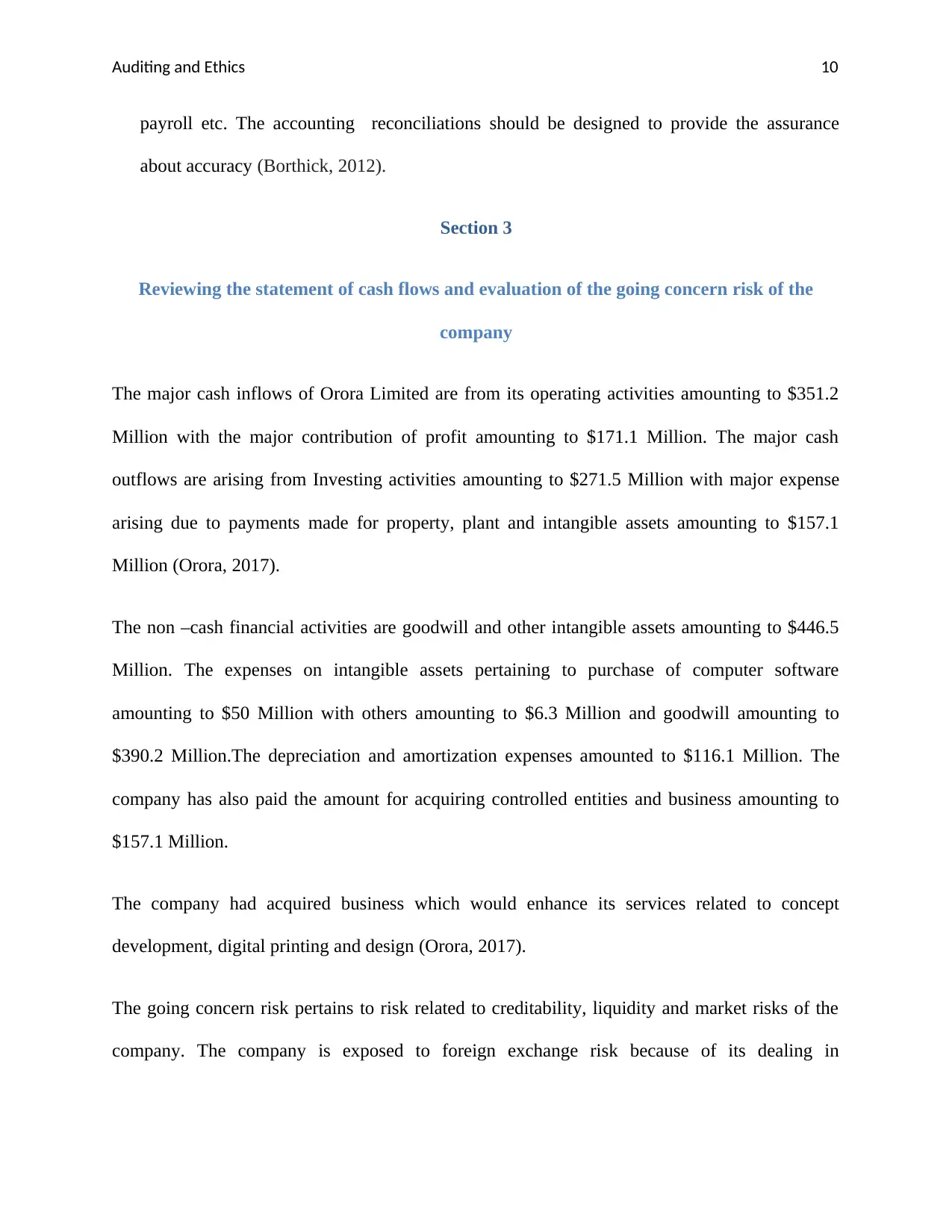
Auditing and Ethics 10
payroll etc. The accounting reconciliations should be designed to provide the assurance
about accuracy (Borthick, 2012).
Section 3
Reviewing the statement of cash flows and evaluation of the going concern risk of the
company
The major cash inflows of Orora Limited are from its operating activities amounting to $351.2
Million with the major contribution of profit amounting to $171.1 Million. The major cash
outflows are arising from Investing activities amounting to $271.5 Million with major expense
arising due to payments made for property, plant and intangible assets amounting to $157.1
Million (Orora, 2017).
The non –cash financial activities are goodwill and other intangible assets amounting to $446.5
Million. The expenses on intangible assets pertaining to purchase of computer software
amounting to $50 Million with others amounting to $6.3 Million and goodwill amounting to
$390.2 Million.The depreciation and amortization expenses amounted to $116.1 Million. The
company has also paid the amount for acquiring controlled entities and business amounting to
$157.1 Million.
The company had acquired business which would enhance its services related to concept
development, digital printing and design (Orora, 2017).
The going concern risk pertains to risk related to creditability, liquidity and market risks of the
company. The company is exposed to foreign exchange risk because of its dealing in
payroll etc. The accounting reconciliations should be designed to provide the assurance
about accuracy (Borthick, 2012).
Section 3
Reviewing the statement of cash flows and evaluation of the going concern risk of the
company
The major cash inflows of Orora Limited are from its operating activities amounting to $351.2
Million with the major contribution of profit amounting to $171.1 Million. The major cash
outflows are arising from Investing activities amounting to $271.5 Million with major expense
arising due to payments made for property, plant and intangible assets amounting to $157.1
Million (Orora, 2017).
The non –cash financial activities are goodwill and other intangible assets amounting to $446.5
Million. The expenses on intangible assets pertaining to purchase of computer software
amounting to $50 Million with others amounting to $6.3 Million and goodwill amounting to
$390.2 Million.The depreciation and amortization expenses amounted to $116.1 Million. The
company has also paid the amount for acquiring controlled entities and business amounting to
$157.1 Million.
The company had acquired business which would enhance its services related to concept
development, digital printing and design (Orora, 2017).
The going concern risk pertains to risk related to creditability, liquidity and market risks of the
company. The company is exposed to foreign exchange risk because of its dealing in

Auditing and Ethics 11
international transactions. The risk is related to its transactions to be conducted in future,
financial assets and obligations which are not denominated in A$.
The audit procedure to mitigate this risk is to verify the register of exposures and foreign
exchange contracts and their related foreign exchange hedges (CPA Australia Ltd, 2009).
It is also exposed to risks related to interest rate, commodity price, employee share plan. For this,
the auditors should assess the various arrangements made by the company to mitigate these risks
like the fixed rate borrowing arrangements and contractually passing of adjustments related to
rise and fall adjustments through consumers.
Other risks are credit risk and liquidity risk. The credit risk pertaining to risk arising from
contracts arising from financial instruments. To mitigate this risk, the auditors should evaluate
the system of counterparty approval and consistent monitoring of exposures (Fukukawa & Mock,
2012).
The liquidity risk pertains to risk arising from operations and external borrowings and to mitigate
it, the auditors must evaluate that the firm has adopted the policy to adopt the flexibility within
the funding structure to meet the working capital and objectives of investments.
Regarding the significant matter related to acquisitions, the opinion of the auditors is that the
implementation of the acquisition method requires estimates and assumptions with regard to the
determination of fair value of any deferred and contingent consideration and the acquired
intangible assets and property (Knechel & Salterio, 2016).
international transactions. The risk is related to its transactions to be conducted in future,
financial assets and obligations which are not denominated in A$.
The audit procedure to mitigate this risk is to verify the register of exposures and foreign
exchange contracts and their related foreign exchange hedges (CPA Australia Ltd, 2009).
It is also exposed to risks related to interest rate, commodity price, employee share plan. For this,
the auditors should assess the various arrangements made by the company to mitigate these risks
like the fixed rate borrowing arrangements and contractually passing of adjustments related to
rise and fall adjustments through consumers.
Other risks are credit risk and liquidity risk. The credit risk pertaining to risk arising from
contracts arising from financial instruments. To mitigate this risk, the auditors should evaluate
the system of counterparty approval and consistent monitoring of exposures (Fukukawa & Mock,
2012).
The liquidity risk pertains to risk arising from operations and external borrowings and to mitigate
it, the auditors must evaluate that the firm has adopted the policy to adopt the flexibility within
the funding structure to meet the working capital and objectives of investments.
Regarding the significant matter related to acquisitions, the opinion of the auditors is that the
implementation of the acquisition method requires estimates and assumptions with regard to the
determination of fair value of any deferred and contingent consideration and the acquired
intangible assets and property (Knechel & Salterio, 2016).
⊘ This is a preview!⊘
Do you want full access?
Subscribe today to unlock all pages.

Trusted by 1+ million students worldwide
1 out of 16
Related Documents
Your All-in-One AI-Powered Toolkit for Academic Success.
+13062052269
info@desklib.com
Available 24*7 on WhatsApp / Email
![[object Object]](/_next/static/media/star-bottom.7253800d.svg)
Unlock your academic potential
Copyright © 2020–2025 A2Z Services. All Rights Reserved. Developed and managed by ZUCOL.




